Lipid exposure activates gene expression changes associated with estrogen receptor negative breast cancer
- PMID: 35508495
- PMCID: PMC9068822
- DOI: 10.1038/s41523-022-00422-0
Lipid exposure activates gene expression changes associated with estrogen receptor negative breast cancer
Erratum in
-
Author Correction: Lipid exposure activates gene expression changes associated with estrogen receptor negative breast cancer.NPJ Breast Cancer. 2023 Mar 13;9(1):11. doi: 10.1038/s41523-023-00516-3. NPJ Breast Cancer. 2023. PMID: 36914690 Free PMC article. No abstract available.
Abstract
Improved understanding of local breast biology that favors the development of estrogen receptor negative (ER-) breast cancer (BC) would foster better prevention strategies. We have previously shown that overexpression of specific lipid metabolism genes is associated with the development of ER- BC. We now report results of exposure of MCF-10A and MCF-12A cells, and mammary organoids to representative medium- and long-chain polyunsaturated fatty acids. This exposure caused a dynamic and profound change in gene expression, accompanied by changes in chromatin packing density, chromatin accessibility, and histone posttranslational modifications (PTMs). We identified 38 metabolic reactions that showed significantly increased activity, including reactions related to one-carbon metabolism. Among these reactions are those that produce S-adenosyl-L-methionine for histone PTMs. Utilizing both an in-vitro model and samples from women at high risk for ER- BC, we show that lipid exposure engenders gene expression, signaling pathway activation, and histone marks associated with the development of ER- BC.
© 2022. The Author(s).
Conflict of interest statement
The authors declare no competing interests.
Figures

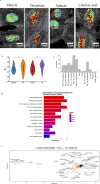
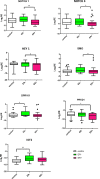
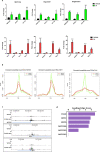

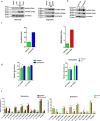

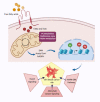
Similar articles
-
Aromatase overexpression induces malignant changes in estrogen receptor α negative MCF-10A cells.Oncogene. 2013 Oct 31;32(44):5233-40. doi: 10.1038/onc.2012.558. Epub 2012 Nov 26. Oncogene. 2013. PMID: 23178495
-
Breast Cancer-Stromal Interactions: Adipose-Derived Stromal/Stem Cell Age and Cancer Subtype Mediated Remodeling.Stem Cells Dev. 2022 Oct;31(19-20):604-620. doi: 10.1089/scd.2021.0279. Epub 2022 Jul 12. Stem Cells Dev. 2022. PMID: 35579936 Free PMC article.
-
Targeting estrogen mediated CYP4F2/CYP4F11-20-HETE metabolic disorder decelerates tumorigenesis in ER+ breast cancer.Biochem Biophys Rep. 2024 Apr 12;38:101706. doi: 10.1016/j.bbrep.2024.101706. eCollection 2024 Jul. Biochem Biophys Rep. 2024. PMID: 38646426 Free PMC article.
-
Leptin-signaling inhibition results in efficient anti-tumor activity in estrogen receptor positive or negative breast cancer.Breast Cancer Res. 2009;11(3):R36. doi: 10.1186/bcr2321. Epub 2009 Jun 16. Breast Cancer Res. 2009. PMID: 19531256 Free PMC article.
-
The crucial role of epigenetic regulation in breast cancer anti-estrogen resistance: Current findings and future perspectives.Semin Cancer Biol. 2022 Jul;82:35-59. doi: 10.1016/j.semcancer.2020.12.004. Epub 2020 Dec 7. Semin Cancer Biol. 2022. PMID: 33301860 Review.
Cited by
-
Tet Transgene Activation is Disrupted in Lipogenic Triple Negative Breast Cancer Cells.ACS Synth Biol. 2025 Jul 18;14(7):2455-2464. doi: 10.1021/acssynbio.4c00851. Epub 2025 Jul 8. ACS Synth Biol. 2025. PMID: 40625278 Free PMC article.
-
Targeting Lipid Metabolism in Cancer Stem Cells for Anticancer Treatment.Int J Mol Sci. 2024 Oct 17;25(20):11185. doi: 10.3390/ijms252011185. Int J Mol Sci. 2024. PMID: 39456967 Free PMC article. Review.
-
Metabolic ripple effects - deciphering how lipid metabolism in cancer interfaces with the tumor microenvironment.Dis Model Mech. 2024 Sep 1;17(9):dmm050814. doi: 10.1242/dmm.050814. Epub 2024 Sep 16. Dis Model Mech. 2024. PMID: 39284708 Free PMC article. Review.
-
Breast cancer prevention with liquiritigenin from licorice through the inhibition of aromatase and protein biosynthesis in high-risk women's breast tissue.Sci Rep. 2023 May 30;13(1):8734. doi: 10.1038/s41598-023-34762-z. Sci Rep. 2023. PMID: 37253812 Free PMC article.
-
A metabolic shift to the serine pathway induced by lipids fosters epigenetic reprogramming in nontransformed breast cells.Sci Adv. 2025 Mar 21;11(12):eads9182. doi: 10.1126/sciadv.ads9182. Epub 2025 Mar 21. Sci Adv. 2025. PMID: 40117373 Free PMC article.
References
Grants and funding
LinkOut - more resources
Full Text Sources
Molecular Biology Databases
Miscellaneous

